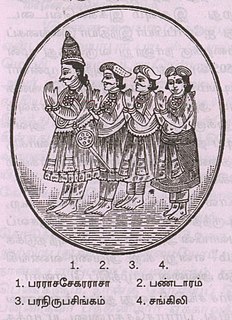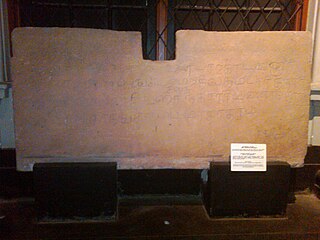
In Sri Lanka, districts are the second-level administrative divisions, and are included in a province. There are 25 districts organized into 9 provinces. Each district is administered under a District Secretary, who is appointed by the central government. The main tasks of the District Secretariat involve coordinating communications and activities of the central government and Divisional Secretariats. The District Secretariat is also responsible for implementing and monitoring development projects at the district level and assisting lower-level subdivisions in their activities, as well as revenue collection and coordination of elections in the district. A district is divided into a number of Divisional Secretary's Divisions, which are in turn subdivided into 14,022 Grama Niladhari Divisions. There are 331 DS divisions in the country.

The Aryacakravarti dynasty were kings of the Jaffna Kingdom in Sri Lanka. The earliest Sri Lankan sources, between 1277 and 1283, mention a military leader of this name as a minister in the services of the Pandyan Empire; he raided the western Sri Lankan coast and took the politically significant relic of the Buddha’s tooth from the Sinhalese capital city of Yapahuwa. Political and military leaders of the same family name left a number of inscriptions in the modern-day Tamil Nadu state, with dates ranging from 1272 to 1305, during the late Pandyan Empire. According to contemporary native literature, such as Cekaracecekaramalai, the family also claimed lineage from the Tamil Brahmins of the prominent Hindu pilgrimage temple of Rameswaram in the modern Ramanathapuram District of India. They ruled the Jaffna kingdom from the 13th until the 17th century, when the last of the dynasty, Cankili II, was ousted by the Portuguese.
Sri Lankan Chetties also known as Colombo Chetties, is an ethnicity in the island of Sri Lanka. Formerly considered a Sri Lankan Tamil caste, were classified as a separate ethnic group in the 2001 census. They were a class of Tamil speaking traders, who migrated from the South India under Portuguese rule.

Karava also Karave, Kara and Kaurawa is a Sinhalese caste from Sri Lanka. The Tamil equivalent is Karaiyar. They are traditionally coastal people occupied in seafaring, fishing and naval warfare.

Govi, Govigama is the largest, highest and the most influential caste in Sri Lanka. They and the Bathgama have traditionally been responsible for cultivation in accordance with the traditional tenure system of land-holding known as Rajakariya (duty).

Ceylon was a British Crown colony between 1815 and 1948. Initially the area it covered did not include the Kingdom of Kandy, which was a protectorate from 1815, but from 1815 to 1948 the British possessions included the whole island of Ceylon, now the nation of Sri Lanka.

The Kingdom of Kandy was an independent monarchy of the island of Sri Lanka, located in the central and eastern portion of the island. It was founded in the late 15th century and endured until the early 19th century.

The Kotagama inscriptions found in Kegalle District in Sri Lanka is a record of victory left by the Aryacakravarti kings of the Jaffna Kingdom in western Sri Lanka. The inscription reads;
"The women-folks of lords of Anurai who did not submit to Ariyan of Cinkainakar of foaming and resounding waters shed tears from eyes that glinted like spears and performed the rites of pouring water with gingerly seed from the bejeweled lotus like hands."
Martanda Cinkaiariyan ascended the throne of Jaffna Kingdom under the throne name Pararasasekaram III. He is one of the early Aryacakravarti kings about whom historical and epigraphical evidence is available. He was noted by Ibn Battuta in his well-known travelogue as well as he has left behind a few inscriptions. He oversaw the international trade of the Jaffna kingdom with Yemen via the kingdom's powerful trading ships. Martanda Cinkaiariyan accompanied Battuta to the peak of Sivanoli Padam Malai along with Yogis and other Hindus and companions of the king who visited the sacred Shiva site annually.
Vanniar or Vanniyar is a title of a chief in medieval Sri Lanka who ruled in the Chiefdom of Vanni regions as tribute payers to the Jaffna vassal state. There are a number of origin theories for the feudal chiefs, coming from an indigenous formation. The most famous of the Vanni chieftains was Pandara Vannian, known for his resistance against the British colonial power.

The Vanni Nadu were feudal land divisions ruled by chiefs south of the Jaffna peninsula in northern Sri Lanka. These chieftaincies arose in the 12th century, with the rise of the medieval Tamil kingdom's golden age and the collapse of the Rajarata kingdom. The chieftaincies developed in sparsely settled areas, and were ruled by Vanniars. An extension of the Jaffna kingdom's territory, the chiefs of the Vanni Nadu were, for most of their existence, tribute-paying subordinates to Jaffna. At 1621, the Jaffna Kingdom was conquered by the Portuguese and the Vanni chiefs became tributaries of the Portuguese Ceylon. The Portuguese colony in Sri Lanka was later taken over by the Dutch. During the Dutch rule it came to Vannian resistances against the colonial rule, one of these was the rebellion of Pandara Vanniyan. Allied with the Kingdom of Kandy, Pandara Vanniyan fought with guerrilla tactics against the Dutch and British. At 1803, he was defeated by Lt. von Driberg and Vanni fell into hands of the British. Vanni had been reincorporated with Jaffna Peninsula to form the Malabar Coylot Vanni country which later became the Northern Province of Sri Lanka.
Bhuvanekabahu VI of Kotte, known also as Sapumal Kumaraya and Chempaka Perumal, was by self admission an adopted son of Parakramabâhu VI whose principal achievement was the conquest of Jaffna Kingdom in the year 1447 or 1450. He ruled the kingdom for 17 years when he was apparently summoned to the south after the demise of his adopted father. According to a primary source Rajavaliya, he killed the grand son of Parakrama Bahu VI namely Vira Parakrama Bahu or Jaya Bahu but Do Couto, however, who was well-informed, says after a few years' reign the king died and his half-witted son was put on the throne by his aunt, who two years later finding herself unable to rule sent for Sapumal Kumaraya from Jaffna.

Nissanka Malla, also known as Kirti Nissanka and Kalinga Lokesvara was a king of Sri Lanka who ruled the country from 1187 to 1196. He is known for his architectural constructions such as the Nissanka Lata Mandapaya, Hatadage and Rankot Vihara, as well as for the refurbishment of old temples and irrigation tanks.

Sri Lanka is divided into 9 provinces, which are further subdivided into 25 districts. Districts are further subdivided into Municipalities, of which are sorted into three categories. Each municipality is divided into Wards and wards into Grama Niladhari divisions.
When to date the start of the history of the Jaffna kingdom is debated among historians.

This is a bibliography of works on Sri Lanka.
The Ceylonese was an English-language newspaper in Ceylon founded by P. Ramanathan and other leading figures. The newspaper started on 5 March 1913 with Americans H. H. Marcus as manager and Tom Wright as editor. The paper was based at Tichborne Hall, Tichborne Avenue in Maradana, Colombo. The paper's other directors included Hector Alfred Jayewardene and Francis de Zoysa. The paper was editorially nationalistic and was run like an American newspaper, a contrast to other Ceylonese papers which were run according to the British model.














